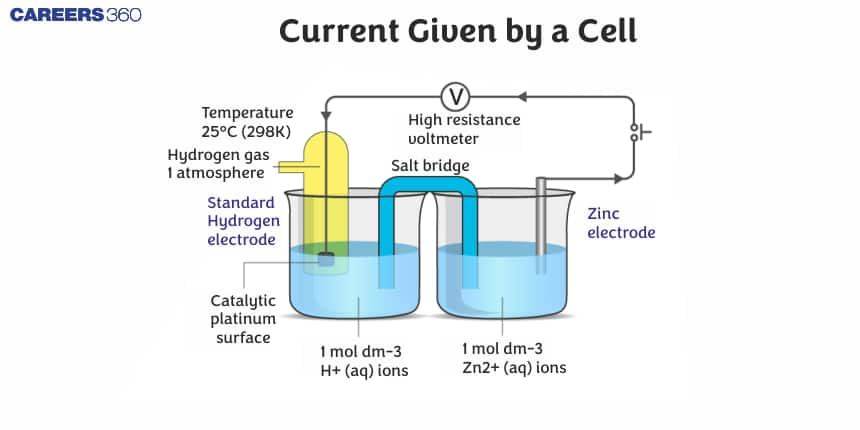Current Given by a Cell
Electric current is the lifeblood of any electrical circuit, much like how blood circulates through the human body to sustain life. Just as our heart pumps blood to provide energy to different parts of the body, a cell or battery pumps electric current to power various components of a circuit. This current, which flows through conductors like wires, enables devices such as lights, fans, and smartphones to function. In our daily lives, we experience the benefits of electric current every time we flip a switch, charge our gadgets, or even when a car engine starts. Understanding the flow of current from a cell helps us appreciate the invisible yet essential force that drives modern technology and keeps our world running smoothly. In this article, we will discuss the concept of current given by a cell and solve examples based on it.
- Current Supplied by the Cell
- The Power Dissipated in External Resistance
- Solved Examples Based on Current Given by a Cell
- Example 1: Find the value of current (in A) through the circuit below if E = 10 V, r+R= 10 ohms.
- Summary

Current Supplied by the Cell
Electric current is the lifeblood of any electrical circuit, much like how blood circulates through the human body to sustain life. Just as our heart pumps blood to provide energy to different parts of the body, a cell or battery pumps electric current to power various components of a circuit. This current, which flows through conductors like wires, enables devices such as lights, fans, and smartphones to function.

Cell supplies a constant current in the circuit.
$i=\frac{E}{R+r}$
R- External resistance
r- internal resistance
Potential drop inside the cell = ir
The internal resistance of the cell
$r=\left(\frac{E}{V}-1\right) R$
The Power Dissipated in External Resistance
When electric current flows through a circuit, energy is transferred from the power source, such as a battery or cell, to various components. A significant portion of this energy is often dissipated as heat in the external resistance connected to the circuit. This phenomenon is akin to the friction experienced when you rub your hands together, where energy is converted into heat. The power dissipated in the external resistance depends on factors such as the magnitude of the current and the value of the resistance itself.
$P=\left(\frac{E}{R+r}\right)^2 R$
Maximum power is obtained when the resistance value of the load is equal in value to that of the voltage source's internal resistance.
Maximum power $P_{\max }=\frac{E^2}{4 r}$
Recommended Topic Video
Solved Examples Based on Current Given by a Cell
Example 1: Find the value of current (in A) through the circuit below if E = 10 V, r+R= 10 ohms.

1) 1
2) 0.11
3) 0.5
4) 0.5
Solution:
Current supplied by the cell

R- External resistance
r- internal resistance
$i=\frac{E}{(r+R)}=1 A$
Hence, the answer is the option (1).
Example 2: Find the value of the internal resistance r circuit below if E = 10 V and the potential drop across $\mathrm{R}=9 \Omega$

1) R/9
2) R/10
3) R/11
4) 9R
Solution:
If V is the potential difference between A and B then
$\begin{aligned} r & =\left(\frac{E}{V}-1\right) R \\ r & =\frac{R}{9}\end{aligned}$
Hence, the answer is the option (2).
Example 3: If in the circuit, power dissipation is 150 W, then R (in ohm) is

1) 6
2) 2
3) 5
4) 4
Solution:
The equivalent resistance is $R_{e q}=\frac{2 \times R}{2+R}$
Power dissipation $P=\frac{v^2}{R}$
$\begin{aligned} & 150=\frac{15 \times 15}{R_{e q}} \\ & \Rightarrow R_{e q}=\frac{15}{10}=\frac{3}{2} \\ & \frac{2 R}{2+R}=\frac{3}{2} \\ & \Rightarrow 4 R=6+3 R \\ & R=6 \Omega\end{aligned}$
Hence, the answer is the option (1).
Example 4: A current of 2 mA was passed through an unknown resistor which dissipated a power of 4.4 W. Dissipated power when an ideal power supply of 11 V is connected across it is :
1) $11 \times 10^{-3} \mathrm{~W}$
2) $11 \times 10^{-5} \mathrm{~W}$
3) $11 \times 10^5 \mathrm{~W}$
4) $11 \times 10^{-4} \mathrm{~W}$
Solution:
$\begin{aligned} & I=2 \times 10^{-3} \mathrm{~A}, P=4.4 \mathrm{~W} \\ & P_{\text {initial }}=P=I^2 R \Rightarrow R=\frac{P}{I^2}\end{aligned}$
$\begin{aligned} & R=\frac{4.4}{4 \times 10^{-6}}=1.1 \times 10^6 \Omega \\ & P_{\text {final }}=P^{\prime}=\frac{V^2}{R}=\frac{11^2}{R}=11 \times 10^{-5} \mathrm{~W}\end{aligned}$
Hence, the answer is the option (2).
Summary
In this article, we explored the concept of electric current supplied by a cell, discussing how it powers electrical circuits and dissipates energy as heat in external resistance. We derived key formulas for current, potential drop, and power dissipation, and applied them to solve examples, demonstrating the practical application of these concepts in circuit analysis. Understanding these principles is crucial for optimizing circuit efficiency and minimizing energy losses.
Frequently Asked Questions (FAQs)
Also Read
02 Jul'25 07:59 PM
02 Jul'25 07:35 PM
02 Jul'25 07:02 PM
02 Jul'25 06:02 PM
02 Jul'25 05:52 PM
02 Jul'25 05:52 PM
02 Jul'25 05:52 PM
02 Jul'25 05:52 PM
02 Jul'25 05:51 PM
02 Jul'25 05:51 PM